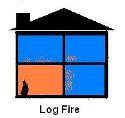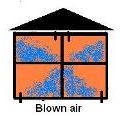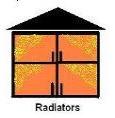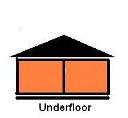Radiant Heat - Why It's so Good
Types of Radiant Heating
- The Sun
- Underfloor Heating
- Electric Heaters
- Gas Heaters
- Hot Water Radiators (20% radiant 80% convection)
- Open Fires
 Our Sun
Our SunOn this page, there are sections on:
What is Radiant Heat?
Our primary source of radient-heat comes from the sun. This heat warms solid objects and our bodies but not the air around us. The heat that we feel from the sun is not warm air but infra-red energy.
How Does it Work?
Radiant-heat moves in straight lines warming all the solid objects in its way. They then act like heat converters giving off warmth which prevent us from losing heat to cold objects such as floors and walls, etc. Radiant-heat, transmitted by electromagnetic waves, occurs directly from warmer to cooler objects, and the air is transparent to this energy transfer.
Note: Electromagnetic radiation travels at light speed from the sun
What Are The Advantages of Radiant Heat?
The human body actually accepts radient heat better than any other form of heating which is why the principle is used in incubators for keeping newborn babies warm.
Your body has its own heating system, but sadly this alone cannot keep you comfortable in cold external temperatures. Your body also loses heat and this is done in three ways
- Radiation is the transfer of heat by direct rays from your body to cooler objects that are around you. If you place your hand next to a block of ice you will feel a chill. This is caused by the rays of heat as they leave your hand and lower your body temperature. Cold walls and floors also draw heat from your body.
- Convection is the transfer of heat from your body which is caused by the movement of air around you. When you turn on a fan it cools you because the draft (cooler air) pulls heat from your body. And even warm air will chill you if it's moving rapidly around you.
- Evaporation is the transfer of heat from your body caused by water drying on your skin (evaporation of sweat), like when you step from a bath or shower.
Remember that your body also acts like a radiator generating it's own heat.
- When you are resting you produce on average about 117 watts or 400 BTU's of heat /hr (values increase with activity). A BTU is a British Thermal Unit - a measurement of heat output.
- You will also give up about 29 watts or 100 BTU´s /hr by expiration (perspiration and breathing).
- 58.6 watts or 200 BTU's is lost through radiation towards the cooler objects around you.
Radiant-heat is a healthy and safe form of heat, it produces no chemicals, dust particles, odours or fumes, making it more appropriate for asthmatics, arthritis sufferers, people with allergies and other chemical sensitivities.
The difference between radient heating and other conventional heating systems (forced air) is that radiant heat controls the rate at which our bodies lose heat. All hot air systems do is just put air into the room without heating the objects in that room. When a hot air system is turned off, the room rapidly loses heat.
Radiant-heat improves the air quality of our homes as air pollutants such as mould, fungi, bacterium and viruses are not blown around as with conventional "forced air" systems. The absence of ducts and air vents also reduces heat loss through infiltration. As well as that, radiant heating systems are quiet.
The image above shows underfloor and radiator systems as better distributors for radiant space heating
The distribution of radient heat by underfloor heating is clearly the better provider as it provides heat completely to all usable areas and can have as many circuits as required (a circuit for each room area).
Forced air systems and single room heat pumps distribute heat unevenly but more importantly into unusable areas such as the ceiling. Movement of hot air also increases the infiltration of colder air into the building, creating a lot of convection currents (draughts) which means cold air at your feet but hot air at head level when you stand, and let's face it, how many of you stand in your lounge or living room? Radiators also create convection currents but these are not blown around and this is a quiet system unlike forced air.
Open fires are romantic and we all like to sit in front of them. But apart from the obvious fire hazards associated with open fires (naked flames) they consume of lot of oxygen which creates major infiltration of cold air. Open fires are room dependent and therefore they provide incomplete home heating.
Radiant heat is clean - fabrics and painted surfaces stay brighter and much fresher because radiant heat carries no grimy fumes nor particles of dust to soil them as with systems such as "forced air". Cold surfaces like the walls and floors attract grime and dust to them more readily than warm surfaces.
The lower temperature required for a radient heat system helps to maintain natural humidity and lower static electricity levels. Additional humidification is unnecessary with a radiant system because radiant heat does not alter air moisture content in your home.
However, good ventilation is a must because most houses on average produce up to 30 liters in water vapour from cooking, washing, showering, etc. A poorly ventilated house will produce mould and fungi, which would be an unhealthy environment to live in.
Why is Underfloor Heating So Efficient?
As a rule conventional stand alone heaters like electric radiant heaters, electric fan heaters, gas fires, forced air and heat pumps disperse their heat unevenly in rooms - on the ceiling and along walls where it is most likely to escape.
With underfloor heating the floor is your radiator and the rising heat is distributed evenly throughout your home. Because the temperature with radiant heat of rooms with underfloor heating remains relatively constant, heat loss can be reduced by as much as 25%.
With radiant heating rooms can remain comfortable at 5 - 6°C lower temperature than conventional heaters. Thermal Heat loss calculation for underfloor heating systems is based on living height areas and not the ceilings which equates to better energy savings.
With radiant-heat, surfaces are not prone to losing heat, so it is not necessary to overheat your home to maintain a comfortable temperature.
Radiant heating tubes (coils), or electric panels are usually mounted in the floor but can also be placed in walls and ceilings. The water temperatures flowing through the pipes should be between 40 - 55°C. The heating pipes are spaced closer together to achieve the higher temperatures used in ceiling installations.
The table below shows an approximate surface temperature and % of heat given off
|
Rooms heated by fan heaters lose heat as soon as they are switched off because they only heat the air, and not the objects, that would then heat the air.
See also:
Click here to visit online store.
Home Heat Loss Heat Gain Radiant Heat Central Heating Radiators UFH
Heat Pumps GSHP's WSHP's ASHP's Solar Heating PV Systems Boilers
Water Heaters Insulation Elec-Heaters
Terms of Use | Privacy | Contact Us

|
Visitors Say
Hi, My name is Shannon and I'm one of home-heating-systems-and-solutions.com readers. I'd like to thank you for the excellent information I've found on home-heating-systems-and-solutions.com, it's one of my favorite readings on the net. Warmest Regards Shannon United States
Thanks for the advice for removing an air lock from an indirect system. Had to change an inlet on my cistern. First time I have tried any home plumbing. After draining the cold tank system air locked when I refilled the tank. Garden hose and mains pressure up the tap sorted my problems. Would not have known what to do without the advice on the site. Many thanks Sean United Kingdom.
An excellent site. I have found it very usefull. I am currently in the design phase of a new house and have be pondering which heat system to use. From your site I have been able to choose the right system. Ross New Zealand
I enjoyed your site. Pat United States
We're so excited to announce our first Children Book
The Special and Talented Dog Show
To order click here
The second book published is called
Flying Things
This is aimed at a pre-school audience and is a rhyming story. You can buy by clicking here
To read more about our children's books, click here







